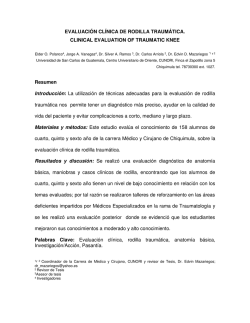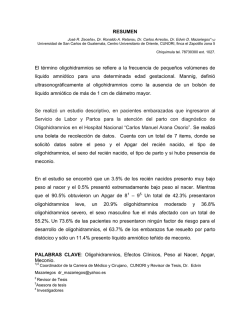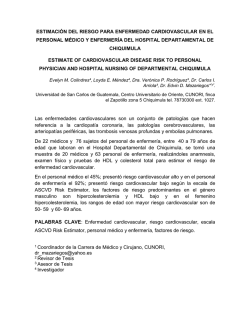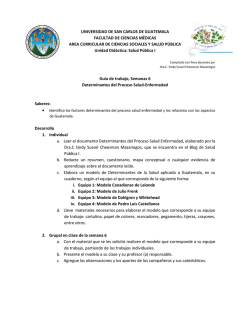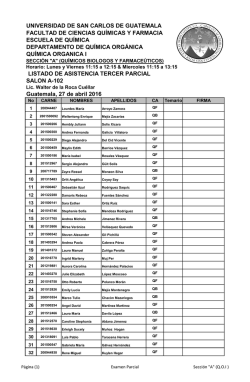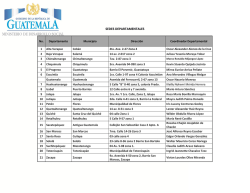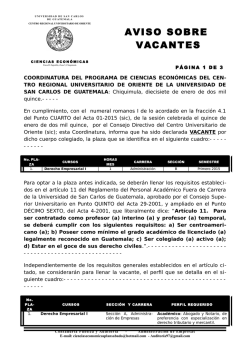
estándares de manejo de profilaxis de enfermedad
ESTÁNDARES DE MANEJO DE PROFILAXIS DE ENFERMEDAD TROMBOEMBÓLICA VENOSA EN PACIENTES ADULTOS CON FRACTURAS ÓSEAS DE MIEMBRO INFERIOR Prophylaxis management standards of venous thromboembolism disease in patients with bone fracture of lower limb 1 2 3 3y4 Ever E. Morataya López* , Dr. Omar Cifuentes* , Dr. Carlos Arriola* , Dr. Edvin D. Mazariegos* . Universidad de San Carlos de Guatemala, Centro Universitario de Oriente, CUNORI, finca el Zapotillo zona 5 Chiquimula tel. 78730300 ext. 1027. Resumen Introducción: La enfermedad tromboembólica venosa es un problema de salud pública a nivel mundial con una relación muy estrecha con la cirugía ortopédica de miembro inferior. El pilar fundamental en la prevención de la enfermedad en cirugía ortopédica se basa en la profilaxis antitrombótica farmacológica y mecánica pre y post operatoria. Anualmente en el Hospital Departamental de Chiquimula se realizan 400 procedimientos quirúrgicos ortopédicos de los cuales el 65% son de miembro inferior . Materiales y métodos: Este estudio realiza estándares de manejo a partir de las “guías y recomendaciones sobre prevención de enfermedad tromboembólica venosa en cirugía ortopédica” de la American College of Chest Physicians del año 2012, donde se utilizó el método Delphy para llegar a un consenso en la realización de estándares de manejo por parte de un grupo institucional de médicos traumatólogos y médicos internistas del Hospital Departamental de Chiquimula. Resultados y discusión: Se llegó al consenso en cirugía ortopédica mayor de utilizar profilaxis farmacológica de primera línea con Bemiparina y Enoxaparina a nivel hospitalario y Rivaroxabán a nivel ambulatorio, con una duración de 10-14 días y profilaxis extendida hasta 35 días en pacientes sin movilización temprana. PALABRAS CLAVE: enfermedad tromboembólica venosa, embolia pulmonar, trombosis venosa, profilaxis antitrombótica, cirugía ortopédica, anticoagulantes, estándares, Centro Universitario de Oriente, CUNORI, Hospital Nacional de Chiquimula. 1 Investigador Asesor 3 Revisor 3y4 Coordinador de la Carrera de Médico y Cirujano, CUNORI y revisor de Tesis, Dr. Edvin Mazariegos; [email protected] 2 PROPHYLAXIS MANAGEMENT STANDARDS OF VENOUS THROMBOEMBOLISM DISEASE IN PATIENTS WITH BONE FRACTURE OF LOWER LIMB 1 2 3 Ever E. Morataya López* , Dr. Omar Cifuentes* , Dr. Carlos Arriola* , Dr. Edvin D. Mazariegos* 3y4 Universidad de San Carlos de Guatemala, Centro Universitario de Oriente, CUNORI, finca el Zapotillo zona 5 Chiquimula tel. 78730300 ext. 1027. ABSTRACT Introduction: venous thromboembolic disease is a public health problem worldwide with a very close relationship with lower limb orthopedic surgery. The mainstay in the prevention of the thromboembolic disease in orthopedic surgery is base on pharmacologic thromboprophylaxis and mechanical prophyplaxis pre and postoperative. Annually in The Departmental Hospital of Chiquimula 400 orthopedic surgical procedures are performed being 65% lower limb. Materials and methods: This study makes management standards from the "guidelines and recommendations on the prevention of venous thromboembolism in orthopedic surgery" of the American College of Chest Physicians in 2012, where the Delphy method was used to reach consensus in conducting management standards by an institutional group of orthopedic physicians and internists of the Departmental Hospital of Chiquimula. Results and discussion: it was a consensus in major orthopedic surgery using first-line pharmacologic prophylaxis with Bemiparin and Enoxaparin in patients within the hospitals and with Rivaroxaban in outpatients, lasting 10-14 days and extended prophylaxis up to 35 days in patients without early mobilization. KEYWORDS: venous thromboembolism, thromboprophylaxis, pulmonary embolism, venous thrombosis, thromboprophylaxis, orthopedic surgery, anticoagulants, standards, Centro Universitario de Oriente, CUNORI, Hospital Nacional de Chiquimula. 1 Researcher 2 Adviser 3 Thesis Reviewer 3y4 Coordinator Race of Medical and surgeon, CUNORI, and thesis reviewer Dr. Edvin [email protected] Mazariegos;
© Copyright 2024
